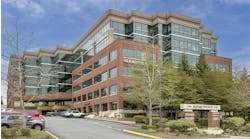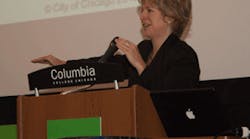CHICAGO — The future of alternative energy, translating sustainability into economic development and the Chicago Climate Action Plan were just some of the topics discussed during GreenTown: The Future of Community, here at Columbia College, Oct. 14, 2010.
During the session From GreenTown to Green Economy: Translating Sustainability into Economic Development, Ronald Fleckman, president and CEO, Energy Recovery Technologies LLC, Evanston, Ill., spoke about developing a proprietary energy recovery ventilation (ERV) technology, which can save commercial and residential building owners more than 50% of their HVAC related energy costs, and creating a company business model.
“I decided to target the HVAC industry,” Fleckman told attendees. “HVAC represents 40% of the energy used in homes and buildings. I wanted to make an impact on greenhouse gas emissions and address indoor air quality. There was too much greenhouse gas being produced and too much energy being used. Plus, too many people are out of work and too many people are being kept out of employment.
“We created a new patent pending technology for ERV and developed a business plan and model,” added Fleckman. “We developed a Triple Bottom Line model, and identified the underemployed work force, created a training program, developed successful opportunities and specialized management training.”
Energy Recovery Technologies is a company built on innovation and environmental, social, community and fiscal responsibility.
The company partnered with Community Builders of Evanston to hire and train employees from an underserved population of Evanston, Ill., to work in various company departments. The company also supports individuals by providing them with green job training, social skills training and basic life skills training. Incentives and encouragement to pursue and/or complete a higher education degree is also provided by the company.
Regardless of the company being socially and environmentally responsible, it is also fiscally responsible and profit conscious.
“In our model, profit is not a dirty word,” Fleckman said as he concluded his presentation. “We are sustainable environmentally and financially. Integrity and transparency is extended to our investors, employees and customers.”
Wind, solar
Pete Kadens, co-founder and president, SoCore Energy, the only solar developer in Chicago, and Joanne Rinaldo, marketing manager, AVA Power Inc., a small wind turbine company based in Round Lake, Ill., discussed the benefits of wind and solar energy during the session The Future of Alternative Energy: Perspectives of Wind and Solar.
According to Kadens, solar has the most room to grow when compared to other alternative energies.
“There is not that big of a disparity in the U.S.,” said Kadens. “Solar has the most room to grow in the U.S. and solar is a good energy source year-round for most areas. At the moment, solar panels are 18-25% efficient, and NASA utilizes panels that are 80% efficient.
“We need policy,” added Kadens. “Many people don’t want to do solar because they think the market will change. Even though solar is a small market, it’s a growing market. It is clean and can meet the energy needs of today and tomorrow.”
When speaking about wind energy, Rinaldo told attendees the way that wind energy is transmitted needs to be developed further.
“You need to get the power you are generating to where you need it,” said Rinaldo when discussing large-scale wind farms. “However, small wind systems that are home based renewable energy systems are most cost effective. They can lower bills 30%-90%.”
Recycled energy
During the Recycled Energy session, Sean Casten, president and CEO of RecycledEnergy Development (RED), Westmont, Ill., discussed fossil fuel emissions and the benefits of recycling energy. RED specializes in projects to capture energy that’s normally wasted and turns it into clean electricity and heat, reducing greenhouse gas emissions, helping manufacturers and institutions save money and cut pollution at the same time.
“The waste from the electric sector is huge and stagnant,” said Casten. “It inflates costs and pollutes too much. For 100 units of fuel, there is 65% waste heat. Recycled energy is the lowest cost source of new power. The only technology that leads to cost reduction is when we use energy twice.”
RED’s approach to energy efficiency includes techniques such as waste heat recovery and cogeneration. Through such techniques, manufacturers cut energy costs substantially, which boosts their competitiveness and reduces their production costs, and recycling energy improves reliability because on-site generation decreases dependence on the electric grid.
Casten used the ArcelorMittal’s steel plant in East Chicago, Ind., as an example of how efficient recycled energy really is.
“This steel plant in Indiana generates more than twice as much clean power as all the grid-connected solar panels in the U.S.,” said Casten.
At the end of his presentation, Casten touched on regulatory reform. According to Casten, there is great potential to cut energy costs and greenhouse emissions by recycling energy, however, the U.S. is way behind other countries because of misguided energy policies.
“Regulations were built for yesterday’s challenges,” said Casten. "There are many policies that stand in the way of developing recycled energy. There are laws, regulations and even the Clean Air Act that discourages energy efficiency."
Chicago Climate Action Plan
During the morning session, Suzanne Malec-McKenna, commissioner of the City of Chicago, Department of Environment, updated attendees on the Chicago Climate Action Plan (CCAP), reviewing the five strategies for mitigating greenhouse gas emissions and future clean energy projects.
According to Malec-McKenna, even though many businesses and residents in Chicago have taken steps to make Chicago a green city, more needs to be done.
“The City of Chicago still has not seen green building across the board,” said Malec-McKenna. “The perspective is still that it costs too much and takes too much extra time to do. Building green isn’t that difficult, it’s just knowing from the design and specs what is going to be used.”
Malec-McKenna continued, “Buildings account for approximately 70% of all green house gas emissions in the city, which are targets for reduction. We plan to continue working on reducing [green house gas emissions] even after Daley’s last term.”
As part of the energy efficient building strategy, 19,600 plus homes and 620 businesses have been retrofitted already, decreasing emissions by 30%, noted Malec-McKenna.
Another part of the CCAP calls for moving to cleaner power sources and procuring enough renewable energy generation to reduce by 20% the carbon emissions caused by generating electricity by 2020.
Malec-McKenna told conference attendees that Chicago is now home to the largest urban solar plant in the country. The plant, located in Chicago’s West Pullman neighborhood, consists of 32,000 solar panels, designed and installed by SunPower Corp., producing enough electricity to power 1,500 homes with zero carbon emissions.
Malec-McKenna also noted that the Chicago Park District incorporates 25% renewable energy into yearly electric purchases and that there will be a solar installation at the Cook County jail in the near future, among other clean energy projects.
She concluded by telling attendees that next year, policy needs to support renewable energy, expansions of renewable energy production and installation opportunities. She also stated that education plays a key role in changing how people view energy and its consumption.
“It’s hard to make an economic argument based on costs,” said Malec-McKenna. “Gas and electric in the Midwest cost much less than in New York and other areas, so economically there isn’t a cost incentive to lower energy use. However, we need to get the community involved and educate them on conservation.”
Related Articles:
GreenTown: Sustainability for future generations



